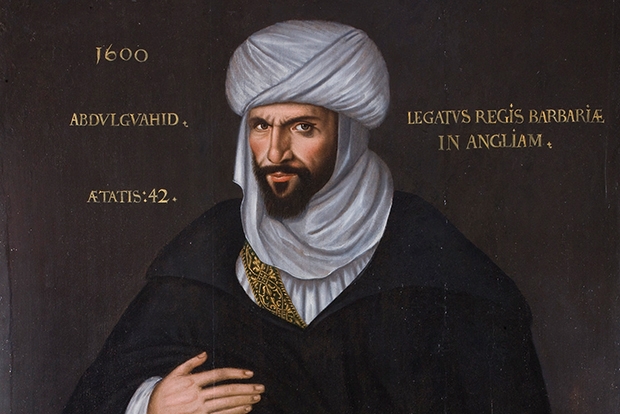The idea for a mechanical cock was never going to work. In 1595 the English ambassador to Constantinople, Edward Barton, advised Queen Elizabeth I that the surest way for her to impress Sultan Mehmed III, the new leader of the formidable Ottoman empire, was to send him a ‘clock in the form of a cock’. Knowing that Mehmed had a growing reputation for psychopathy rather than ornithology — he had his 19 brothers circumcised and then strangled to death — Elizabeth demurred and eventually sent him an elaborate clockwork organ instead. The organ was accompanied by its maker, Thomas Dallam, who spent his first month in Constantinople fixing the damage it had suffered in transit before eventually playing it for the Sultan and his retinue at the Topkapi palace.
However terrifying the gig, the artisan-musician from Warrington thrilled his audience, delighting the Sultan so much that he gave Dallam £20 in gold, letting him play with his scimitar and frolic in his harem. Dallam duly obliged, supplying us in his diary with the first written account in English of a sultan’s harem. Even though Mehmed wanted Dallam to stay indefinitely, he left after a few months, escorted back to his ship by a local translator called Finch who, as a Muslim convert originally from Chorley, knew his companion’s home county of Lancashire every bit as well as the Ottoman territory they traversed.
In Jerry Brotton’s fabulous new book, such encounters reveal both the strangeness of home and just how deep and entangled the roots of the Islamic and Christian faiths were in the early modern period. Brotton’s view of Elizabethan England as an ‘Orient Isle’ contests the idea of the nation existing in splendid or belligerent isolation from the Islamic world, a ‘sceptered isle… a fortress… against infection’ as John of Gaunt puts it in Richard II.
Instead Brotton shows us how ‘Islam… is part of the national story of England’. This isn’t, though, a multiculturalist fantasy in which everyone was always respectfully sensitive to each other’s differences. Rather, Brotton traces how the anxieties, suspicions and xenophobia of Elizabethan Anglo-Islamic relations emerged in tension with the establishment of such trading enterprises as the Barbary Company, the Levant Company and the Turkey Company, whose activities brought riches, tastes and fashions home from an international trade in fabrics, food and munitions with Muslim countries. These diplomatic and economic tensions produced the most profound political and religious uncertainties which, in turn, hothoused some of the greatest English dramatic art.
The trade relations were written all over Elizabeth I’s face, or, at least, in her mouth. Her teeth were blackened by the Moroccan sugar that she and her subjects enjoyed with increasing relish (by 1569 England imported 250 tonnes of it). The Anglo-Islamic political conditions were more difficult to discern but were, nonetheless, unique to the Queen’s 45-year reign. Excommunicated by Pope Pius V in 1570, the Queen and her advisers forged connections with a variety of Islamic kingdoms in order to ensure their safety alongside the great neighbouring Roman Catholic power of Spain. In the wake of that most famous of English military successes, the defeat of the Spanish Armada in 1588, Elizabeth wrote to Ahmed al-Mansur, Sultan of Morocco, telling him of her triumph; in return the Queen was dubbed ‘Sultana Isabel’, and a Moroccan ambassador, Ahmad Bilqasim, was sent to ride in state through London, with the prospect of an Anglo-Moroccan assault on the reeling Spanish a real (if fleeting) possibility. With the accession of James I in 1603 and his vision of rapprochement with Spain, such alliances fell apart.
They made for great theatre, however. Throughout this period there was scarcely a professional playwright who failed to put a Turkish, Persian, Saracen or Moorish character in at least one of their plays. While some of this drama, like Robert Wilson’s The Three Ladies of London (1581), offered only deadening moralism about the risks of trading with Turks, in more expert hands the negotiation of Islamic-Christian relationships became the centrepiece for a new kind of theatrical entertainment which probed the messy, contingent nature of confessional, racial and sexual identity. Thus, Christopher Marlowe’s Tamburlaine (1587), with its infamous Quran-burning scene, showed how all forms of religious zealotry, whether Christian or Islamic, might induce both awe and terror. Marlowe forged a theatre of doubt rather than moral absolutes, inviting audiences to regard such a hot topic very coolly, and ‘applaud it as you please’.
Shakespeare, too, was obsessed with spooling ideas out of Islamic details throughout his theatrical career. Whether reading Portia’s courtship by the Prince of Morocco in The Merchant of Venice, the place of Sycorax, the Algerian mother of Caliban, in The Tempest, or Othello’s suicide, in which he both is and is not the ‘malignant and turbaned Turk’ of his own violent imaginings, Brotton expertly demonstrates how the Islamic world was always much closer to the national poet’s sense of a happy ending or tragic subjectivity than we might ever have thought. Brotton’s Shakespeare is no liberal or post-colonial commentator avant la lettre (a figure who haunts much academic discussion about Shakespeare on race or religion). He is, instead, a brilliant artist enthralled by contemporary politico-religious uncertainties about England’s place in Europe and the competing claims of Christianity and Islam. Brotton’s own book is itself a timely intervention and a marvellous achievement.






Comments